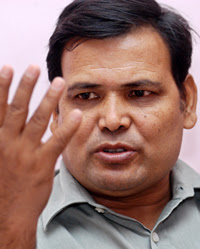 As our seven satraps gloated over Nepal’s gambol to republicanism, two events on the other side offered a gleaming contrast. As Maila Baje surveyed the hundreds of people that converged on the royal palace gates to extend birthday greetings to Crown Prince Paras, the first thing that struck him was the diversity.
As our seven satraps gloated over Nepal’s gambol to republicanism, two events on the other side offered a gleaming contrast. As Maila Baje surveyed the hundreds of people that converged on the royal palace gates to extend birthday greetings to Crown Prince Paras, the first thing that struck him was the diversity.One saw a similar multiplicity at Durbar Marg two weeks earlier, as hundreds assembled in front of King Mahendra’s statue to commemorate his 1960 takeover. If the palace really staged both events – the critics’ standard line – then it did a pretty good job of rounding up a representative sample.
From youths donning baseball caps to older Nepalis attired in their respective cultural brilliance, the turnout epitomized the nation we are being incited to abhor. What inspired these men and women to come out in support of what is increasingly portrayed as a sinking ship? And that, too, amid palpable threats from the more militant sections of the ruling establishment?
Almost two years after the collapse of King Gyanendra’s regime, Maoist guns have fallen silent in deference to a contrived peace process. Who knows when they will start booming again? Moreover, warning shots are being fired from all sides as new disgruntled groups emerge. Pre-1769 Nepal has returned in its full scariness. While everybody is busy articulating their victimhood, petty principalities are looming large in the name of inclusion.
Pashupati Shamsher Rana and Pari Thapa represent opposite poles of the political spectrum. That didn’t stop them from voting against the third amendment to the interim constitution. Madhesi leader Upendra Yadav is already demanding a fourth amendment specifically to address his region’s grievances. And he’s not the only spokesperson for geographically defined grudges.
The advent of a republic has failed to enthuse diehard followers of the seven ruling parties, for different reasons. Deep down, they surely know that it wasn’t part of the original manifesto of the April Uprising. True, venomous anti-monarchy slogans were raised by the tens of thousands who took to the streets. But what about the millions who stayed home? Could any genuine drivers of democracy have the audacity to expropriate the people’s sovereign rights?
With distance, the practical dimensions of change have become too obvious. If the Maoists truly believed the movement was for ending the monarchy, why didn’t they press on and move toward Narayanhity? And why didn’t the mainstream opposition parties rebuff King Gyanendra’s reinstatement of the House of Representatives and push for a full-fledged republic? As for ordinary Nepalis, there is only one way of finding out what they really think. No wonder a referendum on the monarchy is what scares the seven parties.
The goal posts have been shifting in the name of the peace process, primarily because the masterminds of the 12-point alliance are busy playing all sides. At this very moment, New Delhi is probably pressuring the palace on precisely those matters the monarchy has traditionally resisted. With Beijing and Washington having emerged as more robust players since the restoration of democracy, India is probably under new urgency to calibrate its Nepal policy.
The country is a republic, but the monarchy could be abolished if it were found to be conspiring against the constituent assembly elections. The contradiction doesn’t stop there. The Nepali Congress finds it expedient to commemorate National Reconciliation Day while undermining the monarchy B.P. Koirala counseled a rapprochement with in the interest of preserving national independence.
Regardless of the effort the seven parties have put in defending this sleight of hand, the people recognize the 23-point agreement for what it is: an affirmation to hold on to power at all costs.
Few people have a problem with that. What’s galling is the SPA’s haughtiness in blaming the palace for our ills while conceding everything to a growing number of external power centers pushing their own agendas.
In that sense, the royal commemorations convey a larger message. Having been denied the right to determine the future of their country, people are beginning to vote with their feet.




















